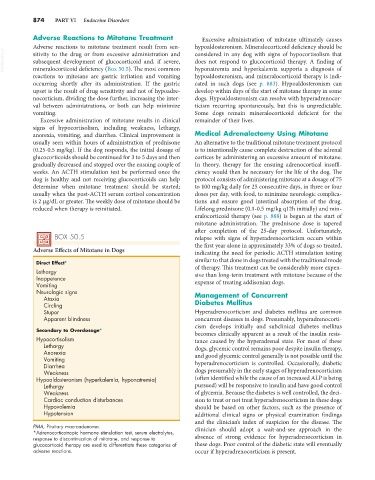Page 902 - Small Animal Internal Medicine, 6th Edition
P. 902
874 PART VI Endocrine Disorders
Adverse Reactions to Mitotane Treatment Excessive administration of mitotane ultimately causes
Adverse reactions to mitotane treatment result from sen- hypoaldosteronism. Mineralocorticoid deficiency should be
VetBooks.ir sitivity to the drug or from excessive administration and considered in any dog with signs of hypocortisolism that
does not respond to glucocorticoid therapy. A finding of
subsequent development of glucocorticoid and, if severe,
mineralocorticoid deficiency (Box 50.5). The most common
hypoaldosteronism, and mineralocorticoid therapy is indi-
reactions to mitotane are gastric irritation and vomiting hyponatremia and hyperkalemia supports a diagnosis of
occurring shortly after its administration. If the gastric cated in such dogs (see p. 883). Hypoaldosteronism can
upset is the result of drug sensitivity and not of hypoadre- develop within days of the start of mitotane therapy in some
nocorticism, dividing the dose further, increasing the inter- dogs. Hypoaldosteronism can resolve with hyperadrenocor-
val between administrations, or both can help minimize ticism recurring spontaneously, but this is unpredictable.
vomiting. Some dogs remain mineralocorticoid deficient for the
Excessive administration of mitotane results in clinical remainder of their lives.
signs of hypocortisolism, including weakness, lethargy,
anorexia, vomiting, and diarrhea. Clinical improvement is Medical Adrenalectomy Using Mitotane
usually seen within hours of administration of prednisone An alternative to the traditional mitotane treatment protocol
(0.25-0.5 mg/kg). If the dog responds, the initial dosage of is to intentionally cause complete destruction of the adrenal
glucocorticoids should be continued for 3 to 5 days and then cortices by administering an excessive amount of mitotane.
gradually decreased and stopped over the ensuing couple of In theory, therapy for the ensuing adrenocortical insuffi-
weeks. An ACTH stimulation test be performed once the ciency would then be necessary for the life of the dog. The
dog is healthy and not receiving glucocorticoids can help protocol consists of administering mitotane at a dosage of 75
determine when mitotane treatment should be started; to 100 mg/kg daily for 25 consecutive days, in three or four
usually when the post-ACTH serum cortisol concentration doses per day, with food, to minimize neurologic complica-
is 2 µg/dL or greater. The weekly dose of mitotane should be tions and ensure good intestinal absorption of the drug.
reduced when therapy is reinitiated. Lifelong prednisone (0.1-0.5 mg/kg q12h initially) and min-
eralocorticoid therapy (see p. 888) is begun at the start of
mitotane administration. The prednisone dose is tapered
after completion of the 25-day protocol. Unfortunately,
BOX 50.5 relapse with signs of hyperadrenocorticism occurs within
the first year alone in approximately 33% of dogs so treated,
Adverse Effects of Mitotane in Dogs indicating the need for periodic ACTH stimulation testing
similar to that done in dogs treated with the traditional mode
Direct Effect*
Lethargy of therapy. This treatment can be considerably more expen-
Inappetence sive than long-term treatment with mitotane because of the
Vomiting expense of treating addisonian dogs.
Neurologic signs
Ataxia Management of Concurrent
Circling Diabetes Mellitus
Stupor Hyperadrenocorticism and diabetes mellitus are common
Apparent blindness concurrent diseases in dogs. Presumably, hyperadrenocorti-
cism develops initially and subclinical diabetes mellitus
Secondary to Overdosage* becomes clinically apparent as a result of the insulin resis-
Hypocortisolism tance caused by the hyperadrenal state. For most of these
Lethargy dogs, glycemic control remains poor despite insulin therapy,
Anorexia
Vomiting and good glycemic control generally is not possible until the
Diarrhea hyperadrenocorticism is controlled. Occasionally, diabetic
Weakness dogs presumably in the early stages of hyperadrenocorticism
Hypoaldosteronism (hyperkalemia, hyponatremia) (often identified while the cause of an increased ALP is being
Lethargy pursued) will be responsive to insulin and have good control
Weakness of glycemia. Because the diabetes is well controlled, the deci-
Cardiac conduction disturbances sion to treat or not treat hyperadrenocorticism in these dogs
Hypovolemia should be based on other factors, such as the presence of
Hypotension additional clinical signs or physical examination findings
and the clinician’s index of suspicion for the disease. The
PMA, Pituitary macroadenoma. clinician should adopt a wait-and-see approach in the
*Adrenocorticotropic hormone stimulation test, serum electrolytes,
response to discontinuation of mitotane, and response to absence of strong evidence for hyperadrenocorticism in
glucocorticoid therapy are used to differentiate these categories of these dogs. Poor control of the diabetic state will eventually
adverse reactions. occur if hyperadrenocorticism is present.

